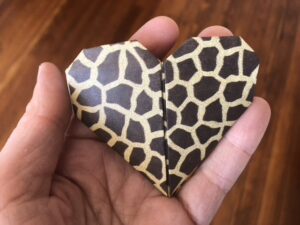Renoir and Hearts

Today was my first ARTZ Philadelphia event as a volunteer-in-training. We visited the Barnes Foundation, where ARTZ Philadelphia director Susan Shifrin began by asking everyone what Valentine’s Day made us think of.
Someone answered “Hearts.” I thought of all the hearts we’re bombarded with on Valentine’s Day – in store displays, greeting cards, and promotional emails. On leaving the event however, a volunteer handed me a Ziploc containing a chocolate and an origami heart made from paper with a leopard-print pattern. As I got home I was on the verge of recycling the heart (we’re constantly trimming my 8-year-old’s mounting stacks of paper projects!), but I held onto it. I think that decision is related to how I’ve held on to certain objects of my mother’s over the past years – objects I’ve always associated with her, but that she’s seemingly forgotten about or lost interest in.
I’m making a theatre piece called “Love you Love you Love you” about my mother and her journey with dementia. The objects I refer to above (mostly Russian toys brought home to Connecticut by my parents after their 4 years in Moscow), have served as inspiration for my piece. As my mom has grown older and more impaired cognitively, these Russian collectibles have grown in significance for me. When we moved her from a condo to an independent living facility, my sister and I wondered which objects still held value for her, which should go to us, and which should be put in the trash. As I make this play about my mom’s dementia, I’ve come to see those objects as extensions of the woman with whom I grew up – a vibrant, embodied woman in her 30s and 40s. The Matryoshka dolls and wooden Kremlin towers represent a mother who had a passionate interest in other cultures and a strong desire to remember her travels.
I thought a good deal about my mom (who still lives in CT) during today’s event at the Barnes. She’s always loved art, and as Susan led the conversation about two Renoirs – “The Luncheon” and “Two Women in the Park, 1875” – I wished my mother had been there. We discussed the things we see when we look more closely at a painting, the details that emerge only when we spend time with it. I wished my mother and I could have spent that reverent hour together contemplating Renoir.
On my way home I listened to a book I’ve been loving called On Vanishing: Mortality, Dementia, and What it Means to Disappear, by Lynn Casteel Harper. Harper starts by discussing still-life paintings from the Dutch Golden Age – paintings called “Vanitas” (same root as “vanish”) – which feature symbols of death and decay. She talks too about the vanishing point, i.e. the point in a painting where all sight lines converge in a single point. Harper turns to paintings to plumb our collective imagination and examine how dementia and dying have been perceived through the ages. She posits that our fear of death and cognitive decline, coupled with our contemporary idolization of youth, have made us push to the margins anyone who doesn’t live up to Western capitalist values of productivity and individualism. But the Vanitas paintings featuring skulls, rotting fruit, etc, give us time and space to contemplate our own leaving, amid a society that does everything it can to keep us working and spending. These paintings elevate dying from a biological process or logistical nightmare, to artful expression.
Today, with ARTZ, I took time with myself and with others, time with Renoir. Time to feel more slowly, breathe more deeply. These days, I must admit, it feels like the time I spend with my mother is limited.
The next time I visit her, I think I’ll bring her to a gallery.

Sarah Sanford is a Philadelphia theatre artist and professor. Her new show about dementia called “Love you Love you Love you” can be seen at the Miniball Festival at the end of March (visit https://www.cannonballfestival.org/)
